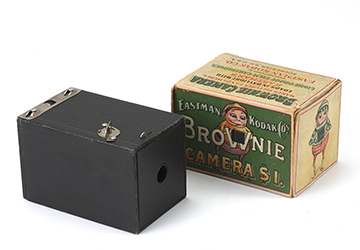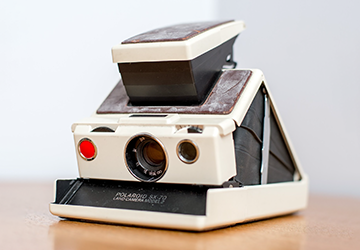Are you a photography enthusiast and want to learn more about the iconic camera? As you know, there are countless camera models in the market, but only a few stand out. So if you're looking for the iconic camera that revolutionized photography, you're in the right place. In this blog post, we round up 5 of the most iconic cameras of all time. These cameras are illuminated, and we're not just talking about their flashy designs. Read on to discover more!
Discover 5 of the most famous cameras that revolutionized photography
Photography has come a long way since the invention of the first camera. Over the years, however, we've seen some truly revolutionary technologies that forever changed the way photographers capture those memorable moments. From the first digital cameras to autofocus models, these iconic cameras introduced breakthrough features that are commonplace in modern photography today.
Here are our top 5 iconic cameras that revolutionized photography.
1. Kodak Brownie (1900)

Features:
● Type: box roll film
● Launched: February 1900
● Video Dimensions: 117
● Image size: 2 1/4 X 2 1/4"
● Lens: meniscus
● Buckle: rotatable
● Manufacturing quantity: 245,000
● Viewfinder: Basic waist-level viewfinder with flap
● Focus: Fixed focus range is about 5-10 feet
● Shutter speed: Single fixed shutter speed about 1/30 second
● Film Advance: simple knob on the side of the camera
● Made in USA
Kodak was a turning point in photography. It was a simple film camera with a fixed focal length lens, the marketing prowess of which attracted millions of people to buy it. It didn't take long for the camera to become a household name.
Kodak's legacy lives on, and it all started with a small camera that changed everything. From its simple design to its unrivaled affordability, the brownie remains an iconic symbol of the democratization of photography.
The camera costs $1.00 and can be used by almost anyone. No wonder it holds a special place in the hearts of photographers and history buffs alike.
2. Leica I (1925)
Features:
● Type: rangefinder camera
● Date of introduction: 1925
● Film size: 35mm
● Image size: 24mm×36mm
● Lens: Leica screw mount
● Production quantity: about 3,000
● Dimensions: 50mm x 100mm x 31mm
● Weight: 125g
● Viewfinder: Coincidence image rangefinder
● Focus: Manual
● Exposure Mode: Manual
● Shutter speed range: 1/20 to 1/500 second
● Origin: Germany
Leica is the groundbreaking 35mm camera that started the portable photography revolution. Conceived by Oscar Barnack and introduced to the world in 1924.
In 1925, the camera quickly found its way into the hands of experienced photographers and became an instant sensation. Its innovative design and portability make it the perfect tool to capture the beauty of the world.
They paved the way for 35mm film photography to become the norm. The Leica I is smaller and more portable than previous cameras.
It remains a much-loved and revered piece of photographic history, a true testament to the power of innovation and the enduring legacy of great design.
3. Nikon F (1959)
Features:
● Type: 35mm SLR camera
● Launched: 1959
● Lens mount: Nikon F mount
● Format: 35mm
● Focus: Manual
● Exposure Mode: Manual, Aperture Priority
● Metering: TTL with silicon photodiode
● Flash: external flash (hot shoe and PC sync socket)
● Flash sync: 1/125s
● Shutter: focal plane shutter, horizontal shooting
● Shutter speed range: 8s to 1/1000s (with bulb)
● Viewfinder: Eye-level pentaprism with interchangeable screens
● Dimensions: 142×57.5×89.5mm
● Weight: 590g
● Made in Japan
The Nikon F is a modular camera that allows photographers to change out lenses, viewfinders and other accessories. It is popular with professionals who need a versatile camera for different tasks.
It was the first DSLR to offer truly professional features. It's also designed from the ground up to be the foundation of a premium SLR system.
Its impact on the industry is huge. Not only that, but it helped Nikon become the leading manufacturer of professional 35mm cameras for over a decade.
Despite its relatively long production life of nearly 14 years, the Nikon F saw little change during its lifetime. This camera is very rare and an excellent example of how a well-designed product can stay ahead of its time.
4. Polaroid SX-70 (1972)

Features:
● Type: Instant folding SLR
● Launched: 1972
● Lens: 4 glass lenses, 116mm f/8
● Focus: manual focus, split image ranging
● Exposure Mode: Manual Override Auto Exposure
● Exposure metering: Polaroid's patented Sonar autofocus system
● Flash: built-in electronic flash connector
● Flash sync: Automatic flash exposure
● Shutter: electronic shutter
● Shutter speed range: 1/175 to over 10 seconds
● Film: SX-70 film
● Dimensions: 17.5 x 10 x 2.5 cm (folded)
● Weight: 756g
● Made in USA
Let's take a trip down memory lane and discover the fascinating world of Polaroid cameras. The Polaroid SX-70 is an instant camera that develops its own photos.
It uses film containing negative and positive layers and develops and produces the final print in minutes. It was the land camera that put the Polaroid on the map.
Additionally, it has become a cultural phenomenon due to its ability to produce photographs that develop instantly before your eyes. Who could forget Edwin Land, the famous inventor behind it???
Stylish, futuristic design and instant gratification make the SX-70 an instant classic. There is no doubt that the Polaroid SX-70 made a huge impression on pop culture and the photography industry.
5. Canon AE-1 (1976)
Features:
● Type: 35mm SLR camera
● Lens mount: Canon FD
● Film speed: ISO 25 to 3200 [Manual]
● Focus: Manual
● Exposure mode: shutter priority, manual
● Exposure metering: EV1 to EV18 at ASA 100
● Flash: hot shoe, PC socket
● Flash sync: 1/60s
● Closing method: winding with the hand lever, unchanged.
● Shutter speed range: 2s to 1/1000s
● Battery: 4SR44 6V battery
● Dimensions: 87×141×47.5mm
● Weight: 590g
● Made in Japan
The Canon AE-1 marked a major shift as photography entered the electronic age. It was the first affordable automatic exposure camera with a microprocessor and revolutionized the market.
Their success was overwhelming, with over 5.7 million units sold worldwide, cementing their place in camera history. But Canon's impact extends far beyond its sales numbers.
It sparked a complete overhaul of Canon's SLR line, moving from a bulky all-metal body to a slimmer, more compact design with integrated electronics.
The Canon AE-1 is a fully automatic camera that uses a microprocessor to control exposure settings. It features a range of automatic and manual modes, making it easy for beginners in photography to use and learn.
Conclusion
Well, these five iconic cameras have shaped the history of photography, revolutionized and transformed the industry. For example, the Kodak Brownie was affordable and easy to use, while the Leica I introduced the breakthrough 35mm format. The Nikon F is also modular. These cameras played an important role in shaping the direction of photography. As technology continues to evolve, we can only imagine new and innovative cameras constantly appearing. These devices will build on the legacy of the aforementioned legendary camera.